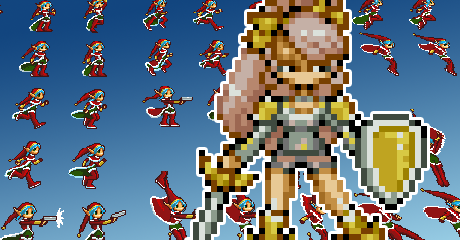How to get FREE ART
Ok, so the title is a little sensationalistic, but I was afraid “How to Make Your Collaborative Project Succeed” was a kind of boring title.
A few times a month I get an email that sounds something like this:
“Hello, I’m [NAME] and I’m working on the super awesome RPG/SHOOTER/MMO! I saw your art on deviantart and was wondering if you want to make art for our game. I can’t pay you, but you will get royalties when the game is successful.”
I always immediately refuse. I feel bad because I know this person really believes in their project, but needs help. A lot of people have good ideas but they just can’t do it themselves, nor do they have the money to pay for professional services and that’s completely understandable. But I’ve seen way too many of these projects fail, and I can’t afford to invest so much time and effort in a someone else’s project when I know people are going to lose interest and the project will fall apart.
But all is not lost! You can get free art for your project! You can even get web designers, programmers and other professionals to offer their services to you! After some experience working on indie projects and working in the game industry, I have picked up a few tips and I’ve created a little guide to getting your project to succeed. Most of this will refer to online collaborative game making, but can likely be applied to any sort of online project, like a web comic, animation, fashion label, etc..
 Start Small
Start Small
Start with a small, simple project. You may have the technology available to you to create something that rivals big budget games out there, but you likely don’t have the time or manpower available to make it work. My advice is not to get too ambitious. Start with something small, absolutely tiny, and build upon it. One finished 25-level puzzle game is worth more than 100 unfinished MMORPGs. Finishing even a small project will really increase your reputation and make people more willing to work with you as your ideas get more ambitious.
Make a plan
This is the MOST important step. It actually has two purposes.
1. It will test your commitment to the project. Creating a detailed plan is a huge time investment, and if you can stick through it, your project has a fighting chance! Sometimes in the process of creating the plan, you will find it’s not that good of an idea, or you’ll lose interest. This is not a bad thing! I myself have had some good ideas for games that were killed in the planning process because as cool as the idea seemed at first, I just couldn’t make it fun. But I don’t feel bad about it because I learned things during the process and I didn’t let anyone down.
 2. The functional purpose of the plan is an obvious benefit once you’ve solidified your idea. It acts as a roadmap and lets you know who you need to help, how long it will take and give volunteers a good overview of the idea. Here are some things your plan needs:
2. The functional purpose of the plan is an obvious benefit once you’ve solidified your idea. It acts as a roadmap and lets you know who you need to help, how long it will take and give volunteers a good overview of the idea. Here are some things your plan needs:
- Game Design Document | If you are designing the game, this is your time to shine! I’m not going to tell you how to create a Game Design Document (or ‘GDD’ ) but basically this is where you need all your details worked out. Here is a guide to writing a GDD.
-
Timetable/Milestones | Your game likely doesn’t have a deadline imposed by anyone, but it’s always good to have a general roadmap of the project. Don’t use any hard dates for these, instead, work in months or weeks. Here’s an example of how you could lay it out.
Month 1 and 2
-Create Character and Background Art
-Create Gameplay Prototype
Month 3
-Create Interface Visuals
-Program Menu and Interface
Month 4
-Beta Testing - Required Assets | Basically, a list of every piece of artwork required for your game. Order it first by the purpose (gameplay, backgrounds, interface, titles, effects), then by priority, so the important stuff is in first and it’s easy to cut out less important assets.
- Your Team | Ideally, create titles for different roles in the project. This way, people can have multiple titles, or the titles can be shifted around as people join or leave your team. Your artist may have the title of “Character Artist” and “Effects Designer”, but if someone good at effects joins your team, they can take on that title. Under each title should include a short description of their role and a list a tasks. This will give you a good overview of who you will need and help you recruit more easily.
- Distribution/Revenue Model | If you plan on making money with your project, make sure it actually can make money! How will you be distributing your game, as a download, or in stores? How will it make money? Pay-per-download? Subscriptions? Ads? You may want to consider creating a business plan. Don’t just plan on getting “discovered”, have a specific plan that you can show your team members.
Make a backup plan
After planning your project, it will be easier to plan for eventualities. If you lose someone from your team, can you replace them? If your project gains momentum but you lose interest, can you pass the project on to a new Lead so that it will live on without you? What if your revenue model doesn’t work? If you have a backup plan for different ways your project could fall apart, it probably won’t!
Acquire a Good Reputation
While you are working on your plan, you can begin to build a good reputation in online communities where you can find people to recruit. Be helpful and take the time to help people and answer questions using your own expertise. If you are generous with your time and advice, people will be much more likely to help you.
 Get Everything in writing
Get Everything in writing
First, make sure every team member knows the terms. Make it clear how, when and how much the member of your team will be paid, even if it is in royalties after the project wraps up. Make sure the team member still gets a portion of royalties for contributing work even if they leave the project. Royalty agreements should be treated as a serious contract, so make sure you get some signatures. This is also where your timetable comes in handy so that your team member knows when they will be paid. Once your project starts, you should have a hard deadline. (example: October 27, 2008)
Have a simple website, and market it!
Once you have a few pieces of artwork, it’s time to show it off! Create a blog so that people can watch the progress of your project, download demos, look at screenshots, read story excerpts… basically, so your audience can get excited about your game! Make sure users have a place to leave comments or feedback. Having an RSS feed or an email newsletter signup will help people keep track of your project. Having a facebook page or twitter account is a great way to keep people up to date as well. When a potential team member sees the excitement surrounding your project and you post an opening, they might even come to you to offering their services!
Provide a place for your team to meet
Luckily this is one that most projects get right. There are many, many ways to collaborate online now, so make sure your team is on the same page. It is easy to set up a free private forum. Provide your team with weekly progress reports to keep them going.
If you can’t provide payment, provide incentives
Royalty incentives become more and more attractive as the project nears completion, but it’s so commonly promised at the beginning of a project that it’s not an incentive at all. (Neither is “exposure”, by the way… if you found them, they likely have a good amount of exposure already.) Consider an “honorarium.” This is more of a small gift for the artist’s efforts than an actual payment, but it shows the artist that you are willing to invest a bit of your own money into the project. Just make sure they know that it is a gift, not a payment or contract.
Lower your Standards If you have a certain style in mind, grab a lot of images that feature that art style. But remember that if your artist is working for free, you need to take what they give you. Being picky or overly critical will make the artist question why they are even on the project and they might even leave your project warning other artists not to join! The art may not be perfect, but it is just a risk you have to take when they are investing their time in your project. Make sure your team members are having fun!
 Break up the work
Break up the work
Keep in mind that many people have a hard time committing to long term projects, so break up the work into bite-size chunks so that you are not asking too much of any one person. This way, you might have multiple artists on the same project, but the work will get done much faster.
Conclusion
It sounds like a lot of work, but remember that you are asking for a lot of work, too. You don’t need to have a huge innovative idea, just something solid.
If I got an email like this, I’m sure I’d be way more likely to say yes:
“Hello, I’m [NAME] and I’m the Lead for [GAME], our team’s second game. I saw your art on deviantart and I think you’d be an awesome addition to our team. You can read more information about the game here: [WEBSITE]. have also attached a plan for the project to this email, feel free to skim it over. We would like to begin development for this game on September 1, 2008 and launch the game on March 1, 2009.
Judging from your art style, I would love for you to design a few characters for us. I can’t pay you in advance, but we can pay you in royalties when the game is successful. Royalties will be negotiated prior to you providing any work and agreed to in a contract. I would like to provide a small gesture of $50 if you decide to be a part of the project for the long term.
Even if you can’t provide us with art at this time, any guidance, advice or creative input you could provide would be of great help. We would like to sign you up to our private forum to see the team in action.
Thanks for taking a look,
[NAME]“
In closing, I’d like sum it all up with three general tips.
- Be professional
- Create a plan
- Make it easy for people to help you
- Make people excited about your project
Good luck on your efforts! I hope this was helpful and if you have any comments or suggestions for this article, do tell. (If anything, those of you who get emails like the one at the beginning of the article can forward people to this.)
Pixel Art by me, Stock Photos from stock.xchng.
 Halloween Anime Pumpkin Video Tutorial
Halloween Anime Pumpkin Video Tutorial Beach Camera Girl Study
Beach Camera Girl Study My top 5 hidden gem songs of 2010
My top 5 hidden gem songs of 2010 G.E.E.R. – The Christmas Game That Never Was
G.E.E.R. – The Christmas Game That Never Was Bacon Ornament Tutorial
Bacon Ornament Tutorial






:origin()/pre01/5e19/th/pre/f/2016/042/3/0/sae_at_the_beach_by_sererena-d9rcwsx.jpg)

:origin()/pre00/4175/th/pre/i/2015/139/6/b/anime_north_2015_flyer_by_sererena-d8tyn1h.jpg)
